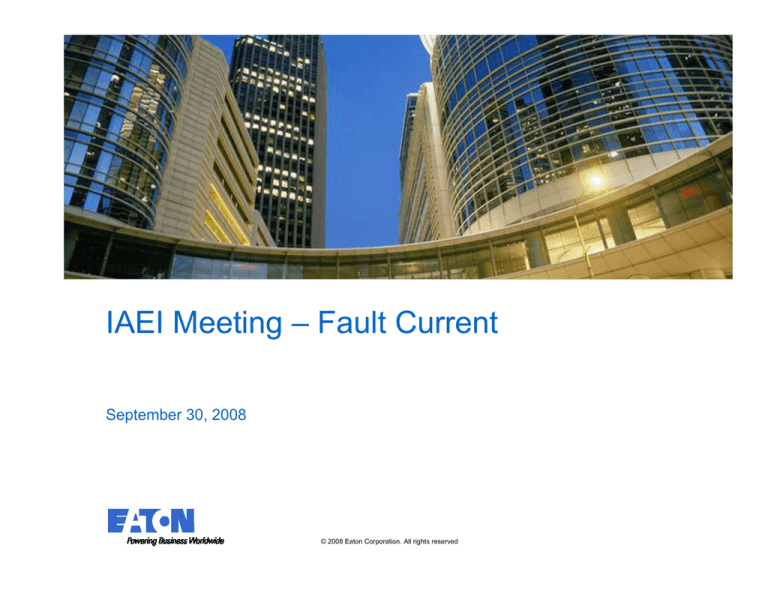
This is a photographic template – your
photograph should fit precisely within this rectangle.
IAEI Meeting – Fault Current
September 30, 2008
© 2008 Eaton Corporation. All rights reserved.
System Faults
A well designed system serve loads with a
minimum of service interruptions.
A short circuit in a system results in a temporary,
uncontrolled current flow in the system
Usually an arc occurs at the point of fault
producing heat, burning conductors and creating a
fire hazard.
3
3
4
4
5
5
6
6
System Faults - Cause
Self Initiated
-Failure of insulation
Forced
-Human error
-Animals
-Trees
-Construction equipment
7
7
System Faults - Type
Line to Neutral (Grd)
Line to Line
8
8
System Faults - Type
Line to Line to Neutral (Grd)
Three Phase Fault
9
9
Line-to-Line-to-Line Fault
Bolted Fault
Systems must be designed
for worst case conditions.
Arcing Fault
However, the majority of faults
will be arcing type.
10
10
Frequency of Faults
TYPE OF FAULTS
INCIDENCE %
FAULT MAGNITUDE
Three-phase bolted
?
Approaches fault available
Single-phase bolted
5%
30-60% of fault available
Line-to-line arcing
15%
Low to medium (less than 30%)
Line-to-ground arcing
80%
Very low to low (less than 10%)
11
11
System Faults
Electrical distribution systems will produce a
Maximum Fault Current that depends upon the
available fault current from the power source and the
impedance in the system at the point of the fault.
Sources
-Utility
-Generators
-Motors
-Batteries
Impedances
-Transformers
-Cables
-Arcing
12
12
Transformer Fault Current
Transformer fault current can be calculated by
dividing full load amps by impedance
1000KVA Transformer at 480V with 5.5% impedance
FLA = 1202A
Fault Current = 1202/.055 = 21,854A
13
13
Motor Fault Current
Practical estimate of motor short-circuit
contribution is to multiply the total motor
currentin amperers by 4
100HP Motor
FLA = 124A
Fault Current = 496A
14
14
System Faults
Primary Fused Switch
Transformer
Available = 65,000 Amps
Distribution
Switchboard
X
Dry Type
Transformer
25,000 Amps
Distribution MCC
Panel
Dist.
Panel
X
Lighting
Panel
X
50,000 Amps 4,800 Amps
15
15
NEC 100 - 2008
Interrupting Rating:
The highest current at rated voltage that a device is
intended to interrupt under standard test conditions.
Interrupting rating applies solely to overcurrent
protective devices such as circuit breakers or
fuses.
16
16
NEC 110.9 - 2008
Equipment intended to interrupt current at fault
levels shall have an interrupting rating sufficient
for the nominal circuit voltage and the current
that is available at the line terminals of the
equipment.
17
17
NEC 100 - 2008
Short-Circuit Current Rating (SCCR):
The prospective symmetrical fault current at a nominal
voltage to which an apparatus or system is able to be
connected without sustaining damage exceeding
defined acceptance criteria
UL specifies that the short circuit rating of assembled
panelboards (switchboards) must not exceed the
rating of the lowest rated device in the assembly.
18
18
NEC 110.10 – 2008
The NEC has requirements for certain components
and equipment to be marked with their short circuit
current rating (SCCR).
230.82 (3) - Meter Disconnect Switches
409.110 - Industrial Control Panels
430.8 - Motor Controllers
440.4 (B) - Air Conditioning and Refrigeration
Equipment with Multimotor and Combination Loads
670.3 (A) - Industrial Machinery Electrical Panel
19
19
Fault Inside MV MCC
20
20
Fault Inside MV MCC
21
21
Series Ratings
22
22
Series Rated Protection
Short circuit rating is assigned to a combination of two
or more overcurrent devices connected in series and
where the rating of the downstream device is less than
that of the combination series rating
23
23
Fully Rated Protection
All overcurrent devices rated for available fault current
24
24
Fully Rated, Sel. Coordinated Protection
A fully rated system with overcurrent devices coordinated
so device closest to the fault opens first
25
25
Article 240-86 Series Ratings
Where a circuit breaker is used on a circuit
having an available fault current higher than its
marked interrupting rating by being connected
on the load side of an acceptable over-current
protective device having the higher rating, the
following shall apply
26
26
Article 240-86 Series Ratings
(a) Marking. The additional series
combination interrupting rating shall be
marked on the end use equipment such as
switchboards and panelboards.
27
27
Article 240-86 Series Ratings
continued
(b) Motor Contribution.
Series ratings shall not be used where
(1) Motors are connected on the load
side of the higher rated overcurrent
device and on the line side of the
lower-rated overcurrent device.
(2) The sum of the motor full-load
currents exceeds 1 percent of the
interrupting rating of the lower
rated circuit breaker.
28
28
Selective
Coordination
29
29
Selective Coordination
Article 700.27 – Coordination
Emergency system (s) overcurrent devices shall be selectively
coordinated with all supply side overcurrent protective devices.
Article 701.18 - Coordination
Legally required standby systems overcurrent devices shall be
selectively coordinated with all supply side overcurrent protective
devices.
Article 517 – Health Care Facilities
517.26 Application of other articles. The essential electrical system
shall meet the requirements of article 700, except as amended by
article 517
30
30
Typical
Transformer
With
Breakers
31
31
Typical
Transformer
With
Breakers
32
32
Arc Flash
33
33
Arc Flash
34
34
What Determines Danger Level
The heat reaching the skin of the worker
is dependent on the following three
factors:
•Power of the arc at the arc location
•Distance of the worker to the arc
•Time duration of the arc exposure.
35
35
NFPA 70 - 2005 National Electric Code
Switchboards, panelboards, industrial control
panels, meter socket enclosures, and motor
control centers in other than dwelling
occupancies, that are likely to require
examination, adjustment, servicing, or
maintenance while energized, shall be field
marked to warn qualified persons of potential
electric arc flash hazards. The marking shall be
located so as to be clearly visible to qualified
persons before examination, adjustment,
servicing, or maintenance of the equipment.
36
36
36
37
37
38
38

